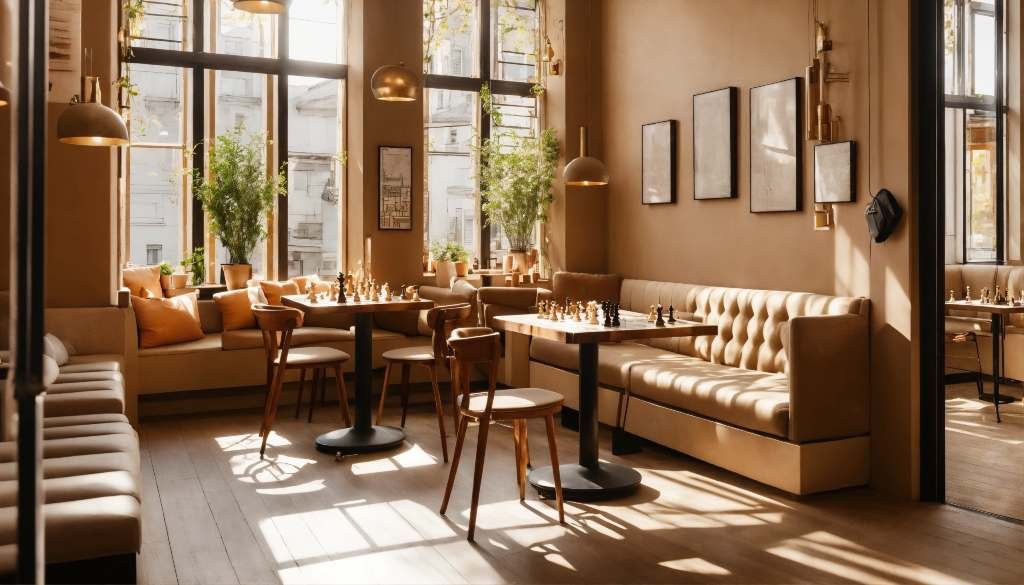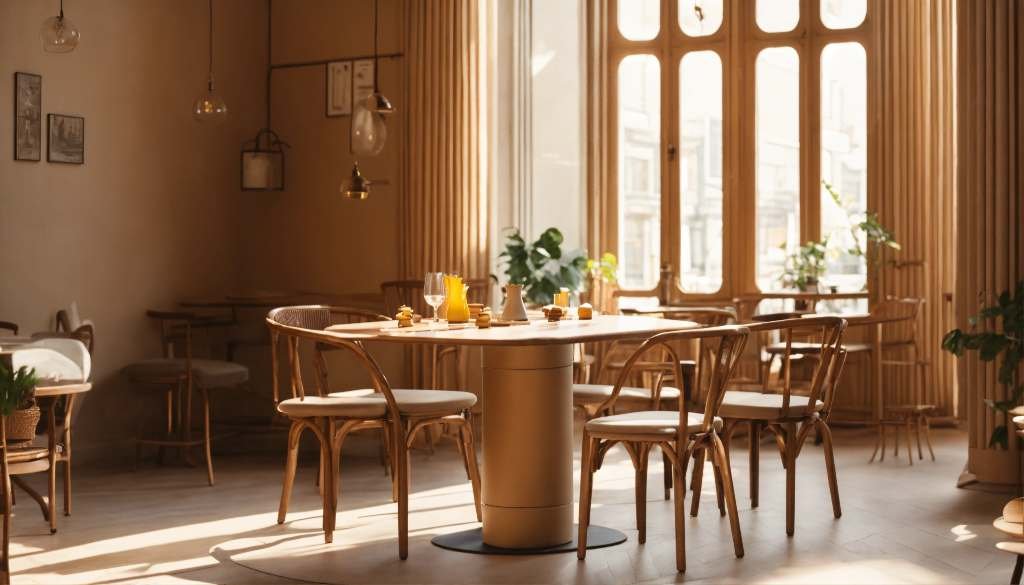A restaurant is more than simply a place to eat delicious food; it’s an immersive experience in which every detail contributes to the overall atmosphere. One frequently neglected but critical feature is restaurant furniture, a silent conductor arranging the symphony of a wonderful eating experience. This article dips into the delicate mix of elegance and comfort, examining how restaurant furniture influences customer impressions and happiness.
The aim of this article is to highlight the crucial role that restaurant furniture plays in shaping the overall dining experience for customers. It aims to inform restaurant owners, managers, and designers about the importance of carefully selecting and arranging furniture to create a welcoming, comfortable, and visually appealing environment that aligns with the establishment’s brand identity.
Readers should focus on the following key points:
- The impact of furniture on customer experience, including first impressions, comfort, and sociability.
- The psychological influence of seating options on customer emotions and satisfaction.
- The importance of catering to different customer preferences through flexible furniture arrangements.
- The role of stylish furniture in expressing the restaurant’s individuality and keeping up with design trends.
- The significance of customization in creating a unique character and enhancing the brand story.
- The prioritization of functionality, ergonomics, and durability in restaurant furniture.
- The art of space optimization and the importance of accessibility and maintenance considerations.
- The challenge of striking a balance between style and comfort and the role of lighting in enhancing furniture appeal.
- The creation of varied ambiences across different dining zones to cater to diverse customer preferences.
- The importance of curating a timeless look that transcends trends and creates a memorable sensory experience.
Dining Furniture’s Impact on Customer Experience

When customers go into a restaurant, the furniture is their first tactile impression of the establishment’s individuality. The design, colour palette, and layout all convey subtle clues about the dining experience that awaits. Seating choices, ranging from snug booths to community tables, influence how consumers interact, creating a sense of intimacy or sociability. The proper commercial-grade restaurant furniture not only influences first impressions but also plays an important part in creating a friendly environment that goes beyond aesthetics.
Aside from the outward appeal, the psychological influence of sitting options cannot be understated. Customers create emotional ties with dining rooms based on the furniture’s comfort and functionality. The feel of a well-made chair or the support of a properly built booth adds greatly to diners’ overall happiness with their gastronomic trip. It’s more than just sitting; it’s about feeling comfortable, engaged, and ready to enjoy the event.
Understanding different client preferences is critical. Different customers enjoy different atmospheres, and the flexibility of furniture to cater to these preferences is critical. Restaurant furniture influences the dynamics of many social interactions, from solo diners looking for a quiet area to contemplate to bigger groups demanding a communal feast. As a result, the influence of restaurant furniture on customer experience extends beyond plain utility; it shapes the entire character of the dining experience.
The role of stylish restaurant furniture in expressing identity:
- Aesthetically pleasing designs enhance the ambience and create a memorable dining experience.
- Modern, minimalist, vintage, and retro styles cater to different tastes and evoke specific feelings.
- Keeping up with trends is crucial for staying relevant in the competitive dining scene.
- Combining materials and textures has become a defining feature of contemporary design.
Comfortable Restaurant Furniture: Prioritizing Functionality

Comfort is the foundation of a pleasant dining experience, and restaurant furniture must prioritize functionality without exception. Ergonomics takes centre stage, with well-designed chairs and tables ensuring that customers can enjoy their meals without distractions. Durability becomes non-negotiable in the business sphere, as furniture must resist the rigours of frequent use while maintaining its aesthetic appeal.
Space optimization is an art in and of itself, particularly in organizations with restricted square footage. Thoughtful placement of furniture and clever use of seating permutations create an attractive yet functional plan. Cushioning and upholstery choices are about more than looks; they help ensure that patrons have a pleasant and happy dining experience.
Seating configurations are customizable, allowing for flexibility to accommodate different group sizes and preferences. Accessibility considerations are critical in ensuring that the dining environment is friendly to everyone, regardless of mobility problems. Maintenance considerations highlight the necessity of choosing materials that are both visually appealing and easy to clean and maintain in a busy business context.
Striking the Balance: Harmonizing Style and Comfort
Achieving the delicate balance of elegance and comfort presents problems that require careful attention. Lighting has an important role in increasing furniture appeal, generating focus points, and providing depth to the overall mood. The combination of form and function is an ongoing process, with each piece of furniture adding to the establishment’s visual narrative while also fulfilling a functional purpose.
Creating varied ambience across different dining zones provides for a more personalized experience that caters to a variety of consumer preferences. From quiet corners with low illumination to colourful public spaces, furniture choices have a significant impact on the character of each room. Achieving brand consistency in design choices ensures that the restaurant’s visual identity is unified and reinforces its unique selling point.
Curating a timeless appearance that goes beyond trends necessitates a thorough understanding of the brand’s values. While trends come and go, a well-planned mix of timeless components keeps the restaurant’s aesthetic fresh and appealing to a wide range of customers. The idea is to create a wide sensory experience, especially if you are opening a new restaurant, that consumers will remember.
Designing Tomorrow’s Dining Experience

In the dynamic environment of restaurant design, the interplay of elegance and comfort demonstrates the ever-changing character of gourmet encounters. The meticulous selection of restaurant furniture extends beyond the simple placement of tables and chairs; it defines the narrative of the dining establishment, leaving an indelible impression on clients’ recollections.
Concluding Lines
As we look to the future, restaurateurs and designers will continue to be guided by the imperative of harmonizing form and function. This precise balance highlights the long-term impact of furniture choices, paving the way for the creation of immersive and unique dining spaces. The paper calls for an approach that recognizes the changing character of the culinary landscape and encourages further research of design ideas.
In the ever-evolving landscape of restaurant design, the interplay between style and comfort reflects the dynamic nature of culinary experiences. The thoughtful selection of restaurant furniture goes beyond mere placement; it defines the narrative of the dining establishment, leaving a lasting impression on customers’ memories.
As the industry looks towards the future, restaurateurs and designers will continue to be guided by the need to harmonize form and function. This delicate balance underscores the enduring impact of furniture choices, enabling the creation of immersive and distinctive dining spaces. The article calls for an approach that acknowledges the evolving nature of the culinary landscape and encourages further exploration of design concepts.
Recognizing the constantly changing world of restaurant design, the article advises the industry to remain informed about emerging trends, technologies, and customer preferences. It emphasizes the crucial role of restaurant furniture in shaping the future of dining experiences by achieving a balance between functionality and aesthetic appeal. As we navigate the exciting terrain of culinary evolution, one chair and one table at a time, the symphony of design and comfort continues to unfold, ensuring a rich and immersive journey for every diner.
